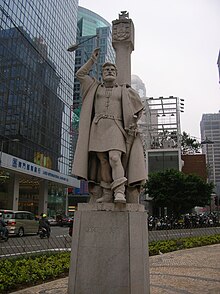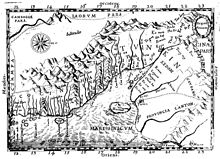Portuguese-Vietnamese relations

|
|
|
|
|
| Portugal | Vietnam |
The Portuguese-Vietnamese relations describe the intergovernmental relationship between Portugal and Vietnam . The countries have had direct diplomatic relations since 1975. Europe first gained more precise knowledge of Vietnam through the first Portuguese travelers in the early 16th century. In addition, the Portuguese created the Quốc Ngữ script, which is still used today, as the Latin form of the Vietnamese language in the 16th and 17th centuries .
The bilateral relations are now considered to be problem-free, but are only slowly becoming more intensive, as there are comparatively few current points of contact between the two countries. Historians' interest in the common history has increased since the 500th anniversary of the first Portuguese-Vietnamese contacts. A series of events took place from 2014 to 2016, including a. scientific colloquia and lecture series.
The Portuguese Post Office CTT Correios de Portugal issued a stamp in 2016 to commemorate 500 years of Portuguese-Vietnamese relations.
history
16th and 17th centuries

The first Portuguese-Vietnamese contact probably took place on the first Portuguese trip to China in 1513, when Jorge Álvares sailed to the Pearl River . The Portuguese were already involved in the Indian trade and were now trying to gain access to the Chinese market. The usual route from Malacca to the Chinese coast, which was already shown on a map by the Portuguese cartographer Francisco Rodrigues from 1512, included stopovers on the coast of what is now Vietnam, then known as Champa and Cochinchina . The area itself did not arouse any interest from Portugal, which was looking for major regional trading cities on the coast. However, there are indications in the records that afterwards Portuguese traders regularly traveled to what is now Vietnam to trade ivory and other goods.
On the way to Malacca, back from an unsuccessful trip to China, Duarte Coelho Pereira , later first governor of the Brazilian captaincy of Pernambuco , made a stopover in 1522 in the port called Porto da Varela in Pulo Champello on the island of Hòn Lao (today part of the Cu-Lao -Cham Nature Reserve ). Here he is said to have left a mark in the form of a cross with the date and a few words about the Portuguese presence, which is attested by the notes of Fernão Mendes Pinto , who later came by there himself.
After the establishment of the Portuguese trading base in Macau in 1557, contacts between the Portuguese and Vietnam intensified. Hội An , called Faifo by the Portuguese , was a frequent port of Merchants from Macau. In addition, the Nguyễn dynasty was just expanding its rule over ever larger parts of Vietnam and was interested in technologically advanced weapons that they could obtain via Macau to secure their rule. Cannons from the Portuguese possession of Macau were then regularly delivered to Vietnam. A search for the remains of these cannons and an investigation of possible influences of Portuguese shipping on Vietnamese shipbuilding, for example, is still pending. Portuguese influences seem likely, however, based on the regular trade contacts between Macau and the Vietnamese coast that lasted until the late 18th century.

The Jesuit missionaries , on the other hand, are likely to have left clearer Portuguese traces in Vietnam . They founded a number of Catholic parishes and built a few dozen churches, most of them from local building materials, but others also clearly European in design. The current Christian population of Vietnam of three to six million people (see Vietnam # Religion ) can be traced back to this Jesuit missionary activity.
Of particular importance was the expansion and dissemination of knowledge about Vietnam in Europe by the Jesuits. The letters of the Portuguese António Francisco Cardim , which made Vietnam known in Europe, should be mentioned in particular . The studies of the Annamite language by the Portuguese clergyman Francisco de Pina in the first decades of the 17th century are also important. For him, the system goes Scripture transmission in the Western Script back that used to date Quoc Ngu .
During the 17th century, Portuguese missionaries wrote a variety of religious and technical texts in Annamite. Father Alexandre de Rhodes built on these and Francisco de Pinas texts when he created his Dictionarium Annamiticum Lusitanum et Latinum , which appeared in Rome in 1651. This was the first Vietnamese language dictionary printed in Europe.
In Portuguese archives, especially in the Biblioteca do Palácio da Ajuda in Lisbon , there are a large number of unpublished linguistic and other records on Vietnam.
Since the 18th century
Special mention deserves the clergyman João de Loureiro , who wrote his famous Flora cochinchinensis back in the 18th century in Europe after staying in Vietnam for decades . Published in Lisbon in 1790, the book describes the nature of the land and the uses of its plants. The botanist was probably also the author of a number of manuscripts, partly Portuguese and partly Vietnamese, about the language, nature and history of today's Vietnam. These writings, among which is a valuable herbarium , have only just been evaluated to date.
After the colonial power France took possession in the 19th century, but especially after the destruction caused by the Indochina War (1946–1954) and the subsequent Vietnam War (1955–1975), hardly any traces of Portuguese influence can be found in Vietnam. In contrast, there is a rich legacy of documents, most of which are still to be evaluated by research. They provide a wide range of information on the history of Vietnam and thus also the historical Portuguese-Vietnamese relations, which were closely related to the Portuguese possession of Macau.
However, bilateral relations between the two countries have not yet intensified, so the interest of historians in this area is only at an early stage.
Portugal recognized the independent South Vietnam on May 22, 1956. After the final end of the Vietnam War on May 1, 1975, Portugal established diplomatic relations with the Democratic Republic of Vietnam .
diplomacy
On February 23, 1981, the Portuguese chief diplomat in Bangkok , José Renato Pinto Soares , was the first Portuguese ambassador to Vietnam to bring his accreditation to the government in the Vietnamese capital Hanoi. Portugal is still not present with its own embassy in Vietnam, but has double accreditation there via its embassy in Thailand (as of January 2017).
In the capital Hanoi and in Ho Chi Minh City are honorary consulates of Portugal established.
Vietnam does not have its own diplomatic representation in Portugal either, but is accredited there via its embassy in the Spanish capital, Madrid.
Culture
The Portuguese cultural institute Instituto Camões is present in Vietnam with a language institute and a lecturer at Hanoi University .
The friendship society NamPor - Associação de Amizade Luso-Vietnamita (German: Association of Luso-Vietnamese Friendship) has existed in Lisbon since 2014 . The president and co-founder of NamPor is Thuy Tiên Nguyen de Oliveira , wife of the Portuguese artist Manuel Casimiro de Oliveira , who is the son of the director Manoel de Oliveira .
economy
In 2016, Portugal exported goods and services worth 19.1 million euros to Vietnam (2015: 17.5 million; 2014: 7.9 million; 2013: 9.3 million; 2012: 9.5 million .; 2011: 12.0 million), of which 25.3% machines and devices, 18.3% chemical-pharmaceutical products, 10.2% agricultural products and 7.6% textiles.
In the same period, Vietnam delivered goods and services worth EUR 232.2 million to Portugal (2015: 232.1 million; 2014: 186.1 million; 2013: 196.3 million; 2012: 139.6 million .; 2011: 97.0 million), of which 60.5% machines and devices, 20.3% agricultural products, 7.1% food and 3.0% textiles.
This puts Vietnam in 81st place as a buyer and in 30th place as a supplier for Portuguese foreign trade.
literature
- Roland Jacques: L'Œuvre de Quelques Pionniers Portuguais dans le Domaine de la Linguistique Jusqu´en 1650. Institut national des langues et civilizations orientales , Paris 1995
- Pierre-Yves Manguim: Os Ngyuen, Macau e Portugal. CTMCDP 1999 (1984)
- Benjamin Videira Pires: Taprobana e Mais Além… Presenças de Portugal na Ásia. Instituto Cultural de Macau, Macau 1995
Web links
- Portuguese-Vietnamese relations page of the Diplomatic Institute in the Ministry of Foreign Affairs of Portugal
- As relações luso-vietnamitas nos séculos XVI e XVII - "Luso-Vietnamese relations in the 16th and 17th centuries" , article from September 16, 2014 in the Portuguese-language newspaper Tribuna de Macau from Macau
Individual evidence
- ↑ a b c Overview of diplomatic relations with Vietnam at the Diplomatic Institute in the Portuguese Foreign Ministry , accessed on May 4, 2019
- ↑ Portugal e Vietname, 500 anos de amizade - "Portugal and Vietnam, 500 years of friendship" , entry from January 29, 2015 on the series of events of the Universidade Nova de Lisboa , accessed on February 10, 2017
- ↑ Emissão Filatélica celebra 500 anos das relações entre Vietname e Portugal - “New philatelic publication celebrates 500 years of Portuguese-Vietnamese relations” , article from June 26, 2016 on the website of the Portuguese Post Office CTT, accessed on February 10, 2017
- ↑ a b Fernando Cristóvão (Ed.): Dicionário Temático da Lusofonia. Texto Editores, Lisbon / Luanda / Praia / Maputo 2006 ( ISBN 972-47-2935-4 ), p. 852
- ↑ Article on the early history of Vietnam at www.antontruongthang.com (Vietnamese), accessed on February 10, 2017
- ↑ Overview of Portugal's consular contacts in Vietnam , website of the Portuguese Foreign Ministry for Portuguese travelers and abroad, accessed on December 13, 2019
- ↑ Overview of activities in Vietnam , Instituto Camões website, accessed on February 10, 2017
- ↑ Interview of March 6, 2015 with the President of the Associação de Amizade Luso-Vietnamita of the Portuguese-language newspaper O Clarim from Macau, accessed on February 10, 2017
- ↑ Projeto para "abraço amigo" entre Portugal e Vietname - "Project for a" friendly hug "between Portugal and Vietnam" , article from January 19, 2015 in the Portuguese newspaper Diário de Notícias , accessed on February 10, 2017
- ↑ Bilateral economic relations between Portugal and Vietnam , Excel file retrieval from the Portuguese Chamber of Commerce AICEP , accessed on February 10, 2017

